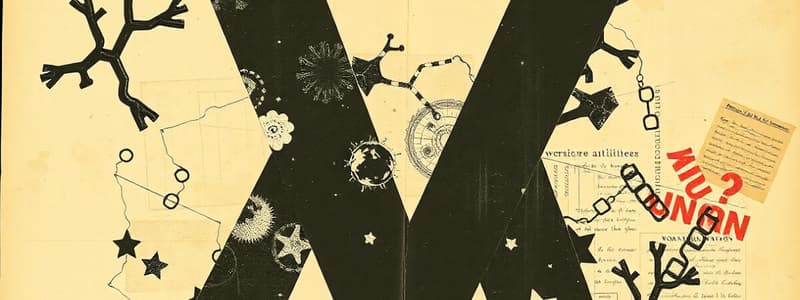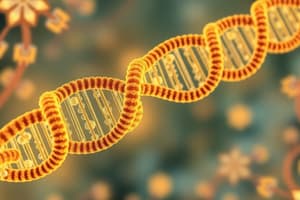Podcast
Questions and Answers
What is the primary function of RNA in protein synthesis?
What is the primary function of RNA in protein synthesis?
- To replicate DNA
- To translate genetic code into proteins (correct)
- To store genetic information
- To assist in cell division
Which step of transcription involves the binding of RNA polymerase to the DNA?
Which step of transcription involves the binding of RNA polymerase to the DNA?
- Initiation (correct)
- Elongation
- Termination
- Processing
What addition occurs during mRNA processing to protect it from degradation?
What addition occurs during mRNA processing to protect it from degradation?
- Poly-A tail
- Ribosome binding site
- Introns removal
- 5' cap (correct)
In which cellular location does transcription occur?
In which cellular location does transcription occur?
What is the significance of adding a poly-A tail during mRNA processing?
What is the significance of adding a poly-A tail during mRNA processing?
What type of molecule is DNA primarily composed of?
What type of molecule is DNA primarily composed of?
Which of the following statements about RNA is NOT true?
Which of the following statements about RNA is NOT true?
What is the direction in which RNA polymerase adds nucleotides during elongation?
What is the direction in which RNA polymerase adds nucleotides during elongation?
What is the primary function of splicing in mRNA processing?
What is the primary function of splicing in mRNA processing?
During which phase of the cell cycle does DNA replication occur?
During which phase of the cell cycle does DNA replication occur?
Which event occurs during the elongation phase of translation?
Which event occurs during the elongation phase of translation?
What signals the termination of translation?
What signals the termination of translation?
What role do single-strand binding proteins play during DNA replication?
What role do single-strand binding proteins play during DNA replication?
Which of the following accurately describes the process of initiation in translation?
Which of the following accurately describes the process of initiation in translation?
What is a key difference between mitosis and meiosis?
What is a key difference between mitosis and meiosis?
During which step of DNA replication is DNA polymerase active?
During which step of DNA replication is DNA polymerase active?
What is the primary difference between necrosis and apoptosis?
What is the primary difference between necrosis and apoptosis?
During which phase of meiosis does the chromosome number reduce from diploid to haploid?
During which phase of meiosis does the chromosome number reduce from diploid to haploid?
Which enzyme is primarily responsible for synthesizing new DNA strands during replication?
Which enzyme is primarily responsible for synthesizing new DNA strands during replication?
In translation, at which stage are the amino acids linked together by peptide bonds?
In translation, at which stage are the amino acids linked together by peptide bonds?
What cellular checkpoint is crucial for preventing the division of cells with damaged DNA?
What cellular checkpoint is crucial for preventing the division of cells with damaged DNA?
What is the role of the p53 gene in relation to apoptosis?
What is the role of the p53 gene in relation to apoptosis?
Which type of RNA is primarily involved in carrying information from DNA to the ribosome?
Which type of RNA is primarily involved in carrying information from DNA to the ribosome?
Which process is characterized as the programmed cell death mechanism?
Which process is characterized as the programmed cell death mechanism?
What is the main difference between the leading strand and the lagging strand during DNA replication?
What is the main difference between the leading strand and the lagging strand during DNA replication?
During which phase of mitosis do chromosomes align at the metaphase plate?
During which phase of mitosis do chromosomes align at the metaphase plate?
What occurs during anaphase of mitosis?
What occurs during anaphase of mitosis?
What is the role of DNA ligase during DNA replication?
What is the role of DNA ligase during DNA replication?
Which checkpoint ensures that the cell is ready to enter the S phase?
Which checkpoint ensures that the cell is ready to enter the S phase?
What happens during cytokinesis?
What happens during cytokinesis?
What is the consequence if the M checkpoint fails?
What is the consequence if the M checkpoint fails?
What is a characteristic of prophase in mitosis?
What is a characteristic of prophase in mitosis?
Flashcards
Protein synthesis
Protein synthesis
The process by which cells create proteins, the building blocks of life that carry out various functions within the body.
DNA (Deoxyribonucleic Acid)
DNA (Deoxyribonucleic Acid)
The molecule that carries the genetic blueprint of the cell, containing two strands forming a double helix.
RNA (Ribonucleic Acid)
RNA (Ribonucleic Acid)
A single-stranded molecule that acts as a messenger, translating the genetic code from DNA into proteins.
Transcription
Transcription
Signup and view all the flashcards
Promoter region
Promoter region
Signup and view all the flashcards
mRNA processing
mRNA processing
Signup and view all the flashcards
Translation
Translation
Signup and view all the flashcards
Ribosomes
Ribosomes
Signup and view all the flashcards
Mitosis
Mitosis
Signup and view all the flashcards
Prophase
Prophase
Signup and view all the flashcards
Metaphase
Metaphase
Signup and view all the flashcards
Anaphase
Anaphase
Signup and view all the flashcards
Telophase
Telophase
Signup and view all the flashcards
Cytokinesis
Cytokinesis
Signup and view all the flashcards
G1 Checkpoint
G1 Checkpoint
Signup and view all the flashcards
G2 Checkpoint
G2 Checkpoint
Signup and view all the flashcards
Splicing
Splicing
Signup and view all the flashcards
Initiation (Translation)
Initiation (Translation)
Signup and view all the flashcards
Elongation (Translation)
Elongation (Translation)
Signup and view all the flashcards
Termination (Translation)
Termination (Translation)
Signup and view all the flashcards
DNA Replication
DNA Replication
Signup and view all the flashcards
Initiation (DNA Replication)
Initiation (DNA Replication)
Signup and view all the flashcards
Elongation (DNA Replication)
Elongation (DNA Replication)
Signup and view all the flashcards
Apoptosis
Apoptosis
Signup and view all the flashcards
Necrosis
Necrosis
Signup and view all the flashcards
Meiosis I
Meiosis I
Signup and view all the flashcards
Meiosis II
Meiosis II
Signup and view all the flashcards
DNA helicase
DNA helicase
Signup and view all the flashcards
p53 gene
p53 gene
Signup and view all the flashcards
Study Notes
Protein Synthesis
- Protein synthesis is the process where cells create proteins, the fundamental building blocks with diverse functions
- Divided into two main stages: transcription and translation
- DNA carries the genetic blueprint, consisting of two strands forming a double helix, each strand with nucleotides containing a sugar (deoxyribose), phosphate, and one of four nitrogenous bases (adenine, thymine, cytosine, guanine)
RNA
- RNA (ribonucleic acid) is a single-stranded molecule that helps convert the genetic code from DNA to proteins
- RNA differs from DNA in that it contains ribose as its sugar and uracil instead of thymine
Transcription
- Transcription is the process of copying a DNA segment into mRNA, occurring within the nucleus
- RNA polymerase binds to the promoter region, initiating the process
- The DNA strands unwind, and RNA polymerase creates a new mRNA strand using complementary RNA nucleotides matching the DNA template strand
- RNA polymerase moves along the DNA, adding RNA nucleotides (5' to 3' direction) to form a growing mRNA strand
- Transcription ends when RNA polymerase reaches a termination sequence; mRNA is then released and prepared for further processing
Translation
- Translation is deciphering mRNA sequence into a polypeptide chain (folds into a functional protein) within the cytoplasm at ribosomes
- Initiation: Small ribosomal subunit links to mRNA near the start codon (AUG); initiator tRNA with methionine attaches. The large subunit joins, completing the ribosome
- Elongation: tRNA carrying specific amino acids enter the ribosome's A site; the anticodon pairs with corresponding mRNA codon. A peptide bond forms between amino acids. Ribosomes shift, moving empty tRNA to the E site and the growing chain to the P site, preparing for the next tRNA
- Termination: The ribosome reaches a stop codon. Release factors detach the polypeptide chain; the ribosomal subunits separate
DNA Replication
- DNA replication is a crucial step in the cell cycle, ensuring each daughter cell receives an exact copy of DNA
- Initiation: DNA helicase unwinds the DNA double helix at specific sites (origins of replication), creating replication forks
- Elongation: DNA polymerase adds complementary nucleotides to each template strand in a 5' to 3' direction; The leading strand is continuous, the lagging strand is discontinuous (Okazaki fragments), joined by DNA ligase
- Termination: Replication continues until the entire DNA molecule is copied, producing two identical DNA molecules (one original and one new strand)
Mitosis
- Mitosis, somatic cell division, creates two genetically identical daughter cells
- Divided into four phases:
- Prophase: Chromatin condenses to form visible chromosomes; nuclear envelope disintegrates; mitotic spindle forms
- Metaphase: Chromosomes align at the metaphase plate; spindle fibers attach to centromeres
- Anaphase: Sister chromatids separate and move to opposite poles of the cell
- Telophase: Chromosomes reach poles, decondense. Nuclear envelopes reform, producing two nuclei in the original cell
- Cytokinesis: Cytoplasm divides, creating two separate daughter cells, each with a complete set of chromosomes
Control of Cell Division
- Cell division is strictly regulated by checkpoints (G1, G2, and M) to ensure proper conditions and prevent errors
- G1 Checkpoint: Determines if the cell is ready for DNA replication
- G2 Checkpoint: Verifies DNA duplication completeness
- M Checkpoint: Ensures accurate chromosome alignment before separation
Necrosis and Apoptosis
- Necrosis: Uncontrolled cell death due to injury, toxins, or infection, causing inflammation and tissue damage
- Apoptosis: Programmed cell death, a controlled process crucial in development, tissue homeostasis, and eliminating damaged or harmful cells
Meiosis
- Meiosis is a reproductive cell division creating genetically diverse gametes (half the chromosome number)
- Meiosis I: Homologous chromosomes separate, reducing the chromosome number to haploid (n)
- Meiosis II: Sister chromatids separate, creating four haploid cells
Multiple Choice Questions
- Multiple choice questions provided for review of concepts, covering enzymes in DNA replication, chromosomal alignment in mitosis, RNA types, stages of translation, ensuring cells with damaged DNA don't proceed to mitosis, and the significance of meiosis
Studying That Suits You
Use AI to generate personalized quizzes and flashcards to suit your learning preferences.




